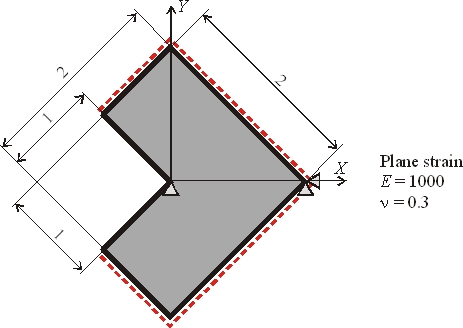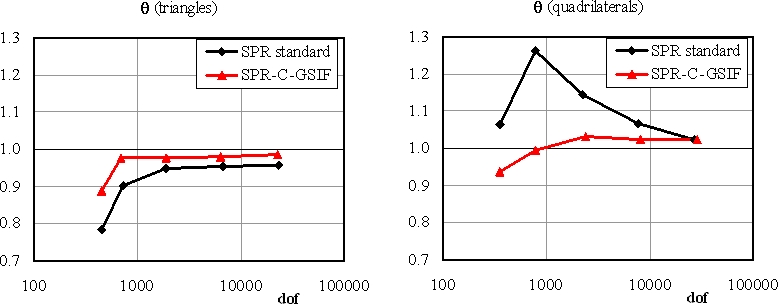
engineering & technology publications
ISSN 1759-3433
PROCEEDINGS OF THE FIFTH INTERNATIONAL CONFERENCE ON ENGINEERING COMPUTATIONAL TECHNOLOGY
A Recovery Error Estimator for Singular Problems Using Singular+Smooth Field Splitting
Research Centre on Vehicles Technology, Department of Mechanical and Materials Engineering, Polytechnic University of Valencia, Spain
In this paper, a new recovery-type error estimator for singular problems in linear
elasticity, called the SPR-C-GSIF technique, has been developed. The idea behind the
new recovery technique is to obtain the recovered stresses
![]() as the contribution of a
singular recovered stress field
as the contribution of a
singular recovered stress field
![]() and a smooth recovered stress field
and a smooth recovered stress field
![]() . The
recovered singular stress field is reconstructed once the generalised stress intensity
factor K (GSIF) is extracted from the standard finite element solution. The value of K, which
characterizes the singular field, is then substituted into the singular analytical
expressions for the stresses to have a better estimate of the singular part of the
stress field. For the smooth recovered stress field, an enhanced SPR technique [2]
which ensures the exact satisfaction of the equilibrium and compatibility equations
of the recovered stresses in the patch is used. The stresses are directly evaluated at the
integration points using a 'conjoint polynomial' enhancement to account for the
different values of stresses obtained at each integration point from different patches.
. The
recovered singular stress field is reconstructed once the generalised stress intensity
factor K (GSIF) is extracted from the standard finite element solution. The value of K, which
characterizes the singular field, is then substituted into the singular analytical
expressions for the stresses to have a better estimate of the singular part of the
stress field. For the smooth recovered stress field, an enhanced SPR technique [2]
which ensures the exact satisfaction of the equilibrium and compatibility equations
of the recovered stresses in the patch is used. The stresses are directly evaluated at the
integration points using a 'conjoint polynomial' enhancement to account for the
different values of stresses obtained at each integration point from different patches.
In order to obtain an accurate estimation of the GSIF, a domain integral approach has been used [3]. The use of domain integrals for characterizing elastic singular problems is very efficient, accurate and easy to implement as a post-processing part of a finite element analysis.
The test problem used in the numerical examples is a portion of an infinite
L-shaped domain which has been loaded with pure mode I stresses, see Figure 1.
Since the effectivity index ![]() is a measure of the ratio of the estimated error
is a measure of the ratio of the estimated error
![]() to
the exact error
to
the exact error
![]() , Figure 2 compares the global effectivity indices obtained using
the proposed method with the results obtained with the standard SPR technique. A
clear improvement can be observed. It has also been checked that the improvement
is remarkable at the local level.
, Figure 2 compares the global effectivity indices obtained using
the proposed method with the results obtained with the standard SPR technique. A
clear improvement can be observed. It has also been checked that the improvement
is remarkable at the local level.
- 1
- O.C. Zienkiewicz, J.Z. Zhu, "The Superconvergent Patch Recovery and a-Posteriori Error Estimates. Part I: The Recovery Technique", International Journal for Numerical Methods in Engineering, 33, 1331-1364, 1992. doi:10.1002/nme.1620330702
- 2
- J.J. Ródenas, M. Tur, F.J. Fuenmayor, A. Vercher, "Improvement of the superconvergent patch recovery technique by the use of constraint equations: the SPR-C technique", Submitted to International Journal for Numerical Methods in Engineering, 2005. doi:10.1002/nme.1903
- 3
- B.A. Szabó, I. Babuška, "Finite Element Analysis", John Wiley & Sons, Inc., New York, 1991.
purchase the full-text of this paper (price £20)
go to the previous paper
go to the next paper
return to the table of contents
return to the book description
purchase this book (price £105 +P&P)

